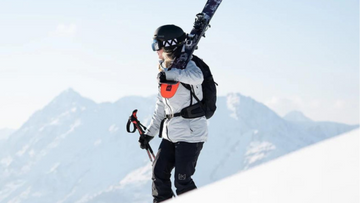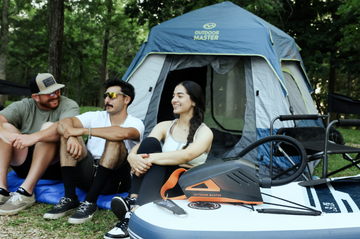What is Mips?

You may have seen the little yellow circle that says Mips on many helmets this ski season, but what does that mean, and what is Mips?
Mips Stands for ‘Multi-Directional Impact Protection System.’ That’s quite a mouthful, but it’ll make sense once you understand the technology that has set this brand apart from others.
With over 25 years of research, Mips has learned that rotational motion is one of the central causes of major head injuries. The level of impact when one hits their head is just one piece of the puzzle when it comes to solving for concussions and other serious head injuries. While Mips cannot stop someone from smacking their head on the snow or other hard surfaces, it can drastically reduce the amount of rotational motion one experiences when taking a big fall.
What is Rotational Motion and How is it Prevented?

Have you ever fallen and hit your head? Were you going straight down and was the ground totally flat? Probably not. Rarely are head impacts linear (direct) and that is due to a host of reasons, but mainly due to velocity and angle.
“When you evaluate all head injuries, then you can see there are very few direct, linear, impacts in contrast to the more angled, or rotational impacts. This rotation gives a tearing injury to the brain tissue, which is a very severe injury.”
- Hans von Holst (Neurosurgeon and Mips Co-Founder)
Up until now, helmets have been designed to protect users from linear motion; i.e. direct impact. However, these kinds of impacts are few and far between. Mips aims to tackle the more common, “oblique” impacts such as ski falls, mountain bike crashes, and even horseback riding tumbles. Rotational motion occurs during these angled impacts.
Rational motion is caused by rotational energy (velocity) and rotational forces (acceleration). This type of impact can cause stretching of the brain tissue, resulting in concussions, minor tears, or, worse, Diffuse Axonal Injury (DAI) and Subdural Hematoma (SDH).
As of 2021, over 140 brands, including Outdoor Master, have adopted Mips technology into their helmets. With growing awareness of the danger of rotational motion, the Mips logo isn’t merely a fashion statement, but a regulative standard worldwide.
Introducing, the Mips Safety System

The Mips safety system is a technology built into the helmets with the intention of redirecting rotational motion away from the head. The technology consists of a low-friction layer between the head and the outer layer of the helmet. In fact, it’s designed to mimic the brain’s ability to allow the brain itself to move slightly within the skull. This low-friction layer allows the head to move 10–15 mm within the helmet during impact.
Most impacts are oblique (angled) rather than (direct) linear. That is why Mips tests all of their helmets at a 45° angle.
Who is the Mips Safety System For?

If you ski or snowboard, you have likely seen the Mips logo on others’ helmets while standing in line for the chair lift or the gondola. That said, Mips tech is found in many helmets across different professions and activities.
Skiing and Snowboarding
The Mips system is used in ski helmets all over the world. Considering it is extremely common for one to fall while skiing and snowboarding, it makes sense that Mips would integrate their technology into these types of helmets. Additionally, experiencing a linear impact while skiing or snowboarding is not as common, which makes rotational motion a serious predicament while crashing on the slopes. That is why the world’s biggest snow brands, such as Anon, Smith, and, yes, Outdoor Master, have partnered with Mips to keep skiers and snowboarders safe.
Biking
Whether it’s for road cycling or mountain biking, Mips technology is an integral part of a helmet’s design with the aim of keeping one’s brain safe from rotational motion and other serious head injuries. The Mips safety system can be integrated into typical cycling helmets as well as full-face mountain biking helmets; ideal for children, and even better for professional athletes at a higher risk of head injury.
Equestrian
Horseback riders take plenty of heavy hits, and falling from a horse’s back while galloping or jumping can be dangerous for all ages and skill levels. That is why Mips tailors their technology to fit into equestrian helmets and is even the official sponsor of the annual Gothenburg Horse Show in Sweden.
Other Helmets
Mips continues to widen its reach within the safety community. The brand also makes Mips safety systems for rock/mountain climbing helmets, motorsports helmets, and even construction helmets.
The History of Mips

The story began in 1996 when Peter Halldin, a researcher at the Swedish Royal Institute of Technology, and Hans von Holst, a Neurosurgeon and professor emeritus, met and together started to develop a ground-breaking technology to improve the way helmets protect the head. Their goal was to achieve better protection against rotational motion transferred to the head, an area of research that received little attention at the time. Several years of research, testing, and development led to innovation, and the Mips system was born.
Later, in 2007, the first ever equestrian helmet was developed featuring Mips technology and sold on the Swedish market. In the early 2010s, the brand decided to sell its technology to helmet manufacturers rather than make helmets themselves. In 2015, Mips sold its safety system to 28 helmet brands, with over a million units produced. As the company continued to grow and develop the technology for other activities, the demand for Mips became more apparent.
As of 2021, Mips has sold over 30 million units across their 140+ partnerships, hopefully supporting saving many brains from the dreaded rotational motion.
Is Mips Really Safer Than Other Helmets?

While it is inconclusive as to how much better a helmet equipped with the Mips system is compared to a non-Mips equipped helmet, the science is there. Rotational Motion is the real deal and Mips intends to help reduce its consequences.
Forbes writer William Roberson spoke with Peter Halldin, Mips Co-Founder and Chief Science Officer, to get the scoop on Mips’ technology.
“In the motorcycle and car industries, acronyms are often dreamed up by marketing people to make a product sound more high-tech or give a catchy name to a feature. When I first saw a helmet with a little yellow “Mips” tag on it, I figured it was more of the same,” William wrote. “But when I did a bit more research, I was happy to find out that Mips is a deeply researched, genuinely effective safety technology.”
Mips Human Testing…

Mips does NOT do human testing. However, I’ve taken some serious falls while snowboarding, and not once have I suffered a head injury (thanks to my helmet!). In January, I traveled to Purgatory Resort in Colorado. While enjoying one of their several terrain parks, I took a fall that ended my ski trip early. I caught my toe edge, like many snowboarders do, and crashed head-first into the snow that was less soft than I’d hoped.
Upon hitting the snowpack, I hit my head with such force that I was sure that ski patrol would be towing me to the nearest emergency room. Luckily, I had no head injury and I am convinced it was because I was wearing my Outdoor Master Elk Mips helmet. Conversely, I suffered an acromioclavicular joint separation in my right shoulder that put me out for two months. Woops!
Is it Worth It?
All this to say, helmets are essential, especially for those of us who love action sports such as skiing, snowboarding, mountain biking, horseback riding, and others. I believe Mips safety systems should become the standard in all types of helmets. I want to make sure I can snowboard for a very long time, and I’d like for my brain to be healthy, too.
Is Mips technology worth it? You bet it is. The next time you go buy a helmet, keep an eye out for that little yellow sticker. It could help save your life.














